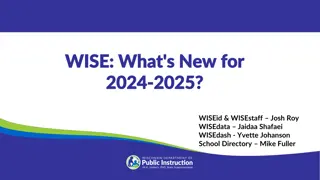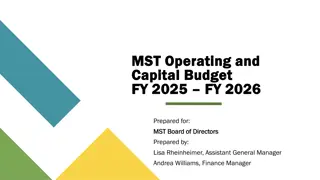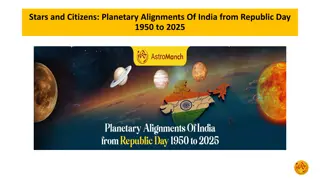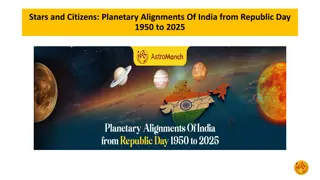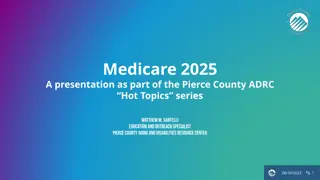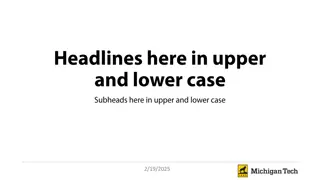
Understanding Lexical Relations in Semantics
Explore the concept of lexical relations in semantics, which focuses on the relationships between words within a language. Learn about types of lexical relations including synonymy and how they affect word usage and meaning.
Download Presentation

Please find below an Image/Link to download the presentation.
The content on the website is provided AS IS for your information and personal use only. It may not be sold, licensed, or shared on other websites without obtaining consent from the author. If you encounter any issues during the download, it is possible that the publisher has removed the file from their server.
You are allowed to download the files provided on this website for personal or commercial use, subject to the condition that they are used lawfully. All files are the property of their respective owners.
The content on the website is provided AS IS for your information and personal use only. It may not be sold, licensed, or shared on other websites without obtaining consent from the author.
E N D
Presentation Transcript
Semantics & Lexical Relations Asst. Asst. Prof Prof Muna English Dep. English Dep. Third Year College of Basic Education College of Basic Education 2024 MunaDalaf Dalaf Third Year 2024/ /2025 2025
Lexical Relations Lexical relations refer to the relationships between words or lexical items within a language. These relations help us understand how words are connected and provide insights into their meanings, usage, and associations
types of lexical relations Some common types of lexical relations include: Synonymy Two or more words with very closely related meanings are called synonyms. They can often, though not always, be substituted for each other in sentences
Synonymy Two or more words with very closely related meanings are called synonyms. They can often, though not always, be substituted for each other in sentences
Examples of synonymy: Almost / nearly Big / large Broad/ wide buy/ purchase Cab/ taxi Car/ automobile Freedom/liberty
However, there are many occasions when one word is appropriate in a sentence, but its synonym would be odd. For example, whereas the words answer and reply are synonyms, one fits in a sentence, while the other doesn t.
Examples: John had only one answer correct on the test. *John had only one reply correct on the test.
Also, at the sentence level, synonymous forms may also differ in terms of formal versus informal uses. For example: My father purchased a large automobile. My dad bought a big car. Both sentences have the same meaning with four synonymous replacements, but the second version sounds much more casual or informal than the first.
Hyponymy When the meaning of one form is included in the meaning of another, the relationship is described as hyponymy.
Lexical Relations Lexical relations refer to the relationships between words or lexical items within a language. These relations help us understand how words are connected and provide insights into their meanings, usage, and associations. Some common types of lexical relations
Synonymy Two or more words with very closely related meanings are called synonyms. They can often, though not always, be substituted for each other in sentences.
Examples of synonymy: Synonym Word large almost big broad buy cab car freedom wide purchase taxi automobile liberty nearly
Antonymy Antonymy : are two forms with opposite meanings. Examples of antonymy Alive/dead big/small fasts/low happy/sad Hot/cold Long/short Male/female married/single Rich/poor true/ false
Hyponymy When the meaning of one form is included in the meaning of another, the relationship is described as hyponymy.
Examples of hyponymy: - animal/horse - insect/ant - flower/ rose - fruit/apple - vegetable/ potato
hypernym We can say that horse is a hyponym of animal and ant is a hyponym of insect. In these two examples, animal and insect are called superordinate/ hypernym (a higher level) terms. We can also say that two or more words that share the same superordinate term are co-hyponyms
More Examples of hyponymy: animal/dog: ( the word dog is a hyponym of animal ), while the word animal is a superordinate /hypernym of dog vegetable/carrot: ( the word carrot is a hyponym of vegetable ), while the word vegetable is a superordinate / hypernym of carrot
Homophones Homophones are two or more words that are different in spelling and meaning, but have the same pronunciation. Common English Homophones are:
Bare Meat Flour Pail Right Week See Bear Meet Flower Pale Write Weak Sea
Homonyms We use the term homonyms when one form (written or spoken) has two or meanings, as in examples below: more unrelated
Examples of homonyms Bat (flying Creature) Bat(used in baseball) mole (on skin/ face) mole (a small thorny animal) bank (a financial institution) bank ( a river side) pen (an enclosed space for animals) pen (a writing instrument)
Polysemy When we encounter two or more words with the same form and related meanings, we have what is known as polysemy. The relatedness of meaning found in polysemy is essentially based on similarity. The head of a company is similar to the head of a person on top of and controlling the body.
Examples of Polysemy head object on top of your body at the top of a company or department foot -of a person / of a mountain of a bed of a document mouth of a p
object on top of your body at the top of a company or department Head of a person of a mountain of a bed of a document Foot of a person of a river of a cave mouth
Metonymy There is another type of relationship between words, based simply on a close connection in everyday experience. That close connection can be based on: a container contents relation (bottle/water, can/juice) a whole part relation (car/ wheels, house/roof) a representative symbol relation (king/crown, the USA President/ the White House).
Using one of these words to refer to the other is an example of metonymy. It is our familiarity with metonymy that makes it possible for us to understand. He drank the whole bottle, although it sounds absurd literally (i.e. he drank the liquid, not the glass object).
We also accept The White House has announced . . . or Downing Street protested. . . without being puzzled that buildings appear to be talking. We use metonymy when we talk about: filling up the car ( the tank, not the car) answering the door ( the person, not the door) boiling a kettle ( the water, not the kettle) giving someone a hand ( help, not a hand)
Collocations We all know which words tend to occur with other words. If you ask a thousand people what they think of when you say hammer, more than half will say nail. If you say table, they ll mostly say chair, and butter elicits bread, needle elicits thread and salt elicits pepper.
Example of Collocations Nail and hammer Table and chair Bread and butter Needle and thread Salt and pepper Cause and effect
More Examples of Collocations We say We don't say fast cars fast food quick cars quick food a quick glance a quick meal a fast glance a fast meal




